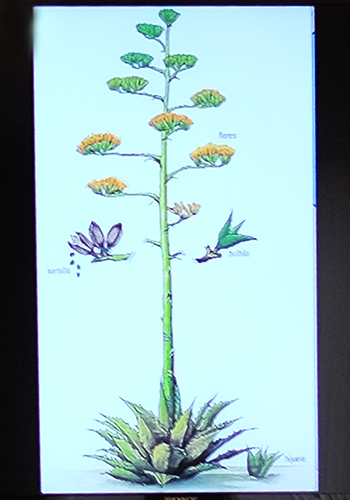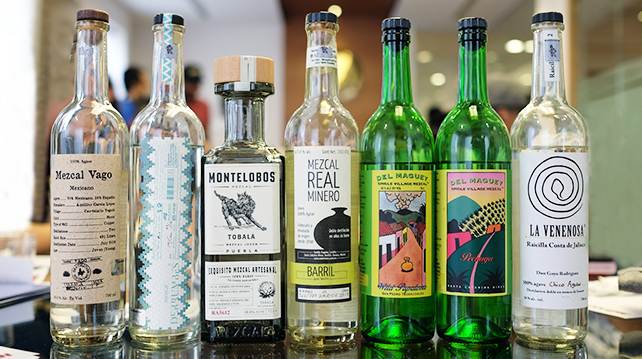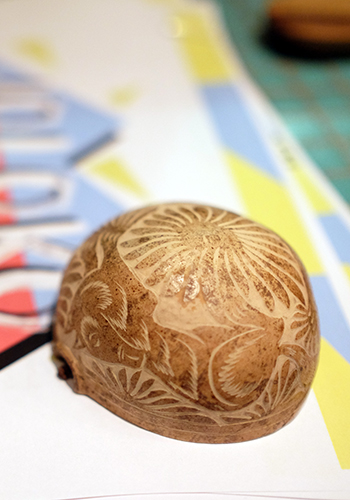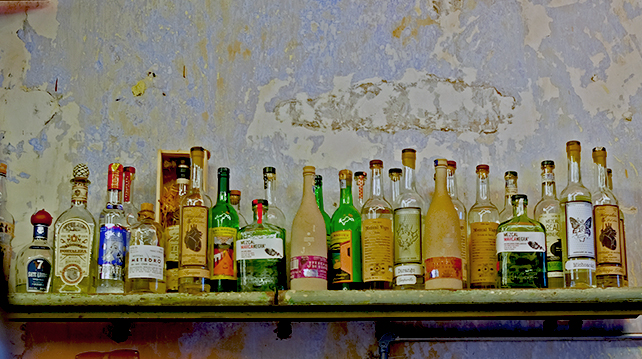[Above: Joloko KL, the first mezcal (tequila) centric bar in Kuala Lumpur]
You may not have heard of mezcal but I’m sure you have heard of tequila, the drink that many take by the shot with a pinch of salt and a slice of lime. “This is not the way you should drink tequila, especially not mezcal,” say Phil Bayly, the Official Mezcal Ambassador in Australia and founder of Agave Love. Let us look at the differences between mezcal and tequila.
Agave / Maguey
Mezcal and tequila are produced from a plant called agave (also called maguey), which is a succulent plant native to Mexico and South America. There are up to 200 different species and 400 varieties. The agave is a complex plant that comprises of 30 big, medium and small chromosomes, which makes the research on the reproduction of each species complicated.
The characteristic of each agave species is unique to its terroir (environmental elements such as climate and soil). As it is a tough plant, it can survive extreme weather with very little water. Their lifespan is between 8 to 35 years, takes between 7 to 15 years to mature, and all these factors affect the taste of the end product.

One of the agave species, which looks very similar to aloe vera but has nothing to do with it.
Not all agave can be made into spirits. Over 30 types (including species and varietals) of agave can be used to make mezcal, out of which over 20 varieties are recognised by the Norma Oficial Mexicana (NOM). The most commonly used varieties are espadin from Oaxaca (pronounced as “wa-huh-ka”), agave esperrima, agave weberi, agave potatorum, agave salmiana, arroqueño, mexicano, cirial, barril, cincoañero and tobalá. Tequila is made from one type only, which is the blue agave (agave tequilana) mainly found in Jalisco.
Production
Tequila is a type of mezcal, and it takes its name after the town where it originated (Santiago de Tequila in the state of Jalisco). The process of making tequila has moved away from the traditional production of mezcal over the years due to the growing popularity of the spirit and has now been industrialised.
|
|
Tequila |
Mezcal |
|
No. of species |
1 species |
35 – 40 species |
|
Production area(s) |
Mainly in Jalisco |
9 recognised states and other different landscapes |
|
Covering ground |
70,000 sq km |
500,000 sq km (biggest in the world for Appellation of Origin) |
|
Production per year |
273 million litres |
2.7 million litres |
|
Stills/vessels |
3,000 – 5,000l stills |
150 – 200 litre vessel |
As of 2016
On the other hand, mezcal remains mostly traditionally produced and since 1 April 2018, the three officially recognised categories of production methods are mezcal (standard), artisanal mezcal and ancestral mezcal.
|
|
Cooking |
Grinding |
Fermentation |
Distillation |
|
Mezcal (like tequila) |
In wells, masonry or autoclave. |
Tahona, Chilean or Egyptian mill, sugar mill, canker, mill train or diffuser. |
Wooden containers, masonry basins or stainless steel tanks. |
Continuous or columns stills of copper or stainless steel. |
|
Artisanal |
In wells or raised masonry. |
Mallet, bakery, Chilean or Egyptian mill, mill or harrow. |
Hollows in stone, soil or trunk, masonry basins, wooden or mud vessels, animal skins. |
Copper stills or stainless steel. |
|
Ancestral
|
In wells.
|
Direct fire in mud pot and mud montera or wood. Process may include the fibre of the maguey or agave (bagasse).
|
Regulations
Both mezcal and tequila are protected by an Appellation of Origin (AO, DO) and are regulated under Norma Oficial Mexicana (NOM), which has a set of compulsory standards and regulations for the diverse activities in Mexico.
The industry body that regulates mezcal under NOM is Consejo Mexicano Regulador (CMR), which originated in 1994 and became law in 2003.
Tequila had an earlier regulatory system in 1959 with CNIT (Camara Nacional de la Industria Tequilera or National Chamber of the Industry of Tequila), formed by members who were distillers and producers of the plant and spirit of tequila. By 1977, they had successfully lobbied for recognition as an appellation similar to Cognac and Champagne. Consejo Regulador de Tequila (CRT), the equivalent of CMR, was formed also in 1994.
CMR and CRT are both independent organisations that play very similar roles. They employ highly trained professionals to conduct on-site inspection for mezcal and tequila, from growth to production. Each team is rotated every 3 months to avoid any possible corruption. The Mexicans treat they local produce very seriously.

Production regions
While there are 28 regions producing mezcal, currently only 9 are legally recognised under the CMR: Oaxaca, Durango, Guanajuato, Guerrero, San Luis Potosi, Tamaulipas, Zacatecas, Michoacan, and Puebla. Out of these 9, Oaxaca and Guerrero are the only 2 states where every producer is registered under NOM. The list is very much influenced by politics and economical reasons. However, more areas continue to be included.
With tequila, although Jalisco is the only state that is allowed to grow blue agave to produce tequila, three other neighbouring states, Michoacan, Guanajuato, and Nayarit that share their borders with Jalisco, together with Tamaulipas, are also producing areas for blue agave. Note that there are two states, Guanajuato and Michoacan, which produce both tequila and mezcal.
Next time when you drink a tequila or mezcal
- Try it in a wine glass instead of a shot glass that retains the aroma and taste profile better during tasting.
- As the alcohol level for the spirit is higher than 37% ABV, unlike wine at below 20%, take only small sniff with mouth slightly open to not burn your senses.
- Take one small sip to coat the mouth. Then take a bigger sip and discover the flavours.

A jicara (pic) is the traditional drinking vessel for mezcal made from fruit of calabash tree.
Classifications
Tequila
- 100% blue agave tequila allows up to 1% additives.
- Tequila (Mixto) uses no less than 51% agave sugar and 49% other sugar, normally sugar cane juice.
Blanco / plata (silver): Unaged clear tequila straight from the still.
Juven / oro (gold): Blanco with added caramel or oak essence.
Reposado: Aged in oak vats or barrel of varying sizes between two months to a year.
Añejo: Aged in oak barrels for one to 3 years.
Extra añejo: Aged in oak barrels for over three years. A new category introduced in 2006 with the producers’ belief that tequila reaches its optimum between 4 to 5 years.
Mezcal
Joven / Blanco: Unaged clear mezcal straight from the still.
Madurado: Rested minimum 1 year in glass containers.
Reposado: Aged in oak cask of varying sizes between two months to less than a year.
Añejo: aged for at least 12 months, sometimes several years in oak casks of sizes up to 200 litres.
Abocado (infused with): With worms or herbs for flavouring.
Distildo (distilled with): Uses vapour to extract flavours from animals, seasonal fruits or anything with protein. Popular during Christmas and Easter for religious purposes.
Pechuga (breast): Mezcal is distilled for the third time with fruits, nuts, grains, seasonal raw food and a chicken breast.
---
Useful links:
- Tequila Wiki in English
- Tequila Official
- Mezcal Wiki n English
- Mezcal Wiki in Spanish
- Mezcal 101
